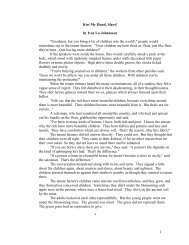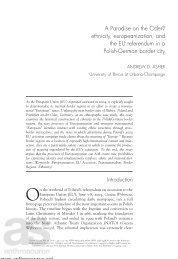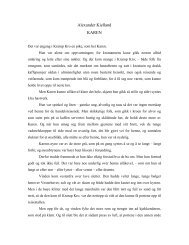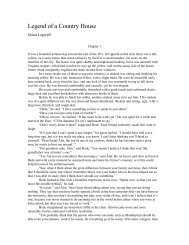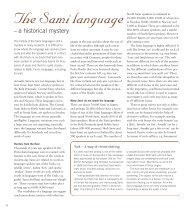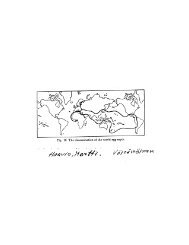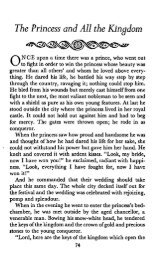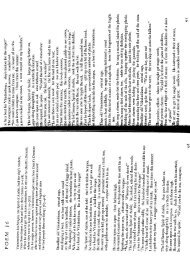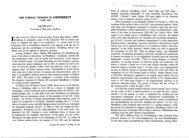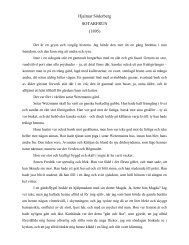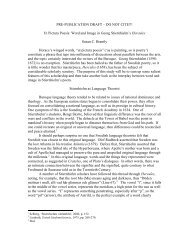Six Views of “The Little Mermaid” - Department of Scandinavian ...
Six Views of “The Little Mermaid” - Department of Scandinavian ...
Six Views of “The Little Mermaid” - Department of Scandinavian ...
You also want an ePaper? Increase the reach of your titles
YUMPU automatically turns print PDFs into web optimized ePapers that Google loves.
156 SCANDINAVIAN STUDIES SPLASH! 157<br />
The warring forces at this level are within a character torn between her will<br />
to achieve her goal and her masochistic, romantic, and Christian passivity.<br />
Confusion <strong>of</strong> Theme<br />
Interpreters have stressed the dualism <strong>of</strong> the story (life versus death, and so<br />
on). But at the level <strong>of</strong> theme the story is not dualistic, it is “symbolic.”<br />
Andersen-through the grandmother-himself gives the clue to the symbolic<br />
system, “ligesom vi dykke op af Havet og see Menneskenes Lande, saaledes<br />
dykke de op ti1 ubekjendte deili e Steder, dem vi aldrig faae at see” [96] (just<br />
as we rise up from the ocean an !I see the lands <strong>of</strong> human beings, so they rise<br />
up to lovely, unknown places, those we never get to see). Seaside versus land<br />
corresponds to land versus heaven. Thus the Mermaid’s longing for the<br />
Prince is not longing for a prince, but “the symbol” <strong>of</strong> a longing for<br />
eternity.<br />
Confusion concerning the theme <strong>of</strong> the story mainly reflects the<br />
reader’s conflict in handling a symbolic way <strong>of</strong> thinking and the author’s<br />
conflict in the strategy <strong>of</strong> symbolizing. The warring forces <strong>of</strong> signification<br />
at the level <strong>of</strong> theme are thus a conflict <strong>of</strong> rhetoric. The symbol (love story),<br />
which should point to something else, has grown so interesting in itself that<br />
it blocks its function <strong>of</strong> transference. This blockage in the symbol’s system<br />
<strong>of</strong> transference can be noticed on several levels. One problem is the double<br />
position assumed by the human side <strong>of</strong> the story: Mermaid is to Prince as<br />
Prince is to Soul. The Prince thus represents both body and soul. Andersen<br />
freely ranges back and forth in this very special symbolic system. In a<br />
crucial paragraph we see the system at work:<br />
nuur ban med hele sin Tank og @rlighed hang ved dig, og lod Prmten<br />
hgge sin hnire Hand i din rned LBfte om Troskub her og i al Evighed, da<br />
fl0d hans Sjzl over i dit Legeme og beholdt dog sin egen. (96; emphasis<br />
added)<br />
(if he clung to you with all his thoughts and love and let his right hand<br />
by the minister be put into yours with a promise <strong>of</strong> faithfulness here<br />
and for all eternity, his soul [would have/jlowed over into your body and<br />
yet kept to its own.)<br />
In this paragraph the Prince’s representing both body and soul is obvious,<br />
most significantly so in the sentence emphasized, in which the metaphor<br />
“flyde” (flow) combines the liquid <strong>of</strong> seed with the airy consistency <strong>of</strong> soul.<br />
Coitus becomes the clue to animation; seed becomes soul. This conception<br />
<strong>of</strong> the male seed as symbol <strong>of</strong> the human soul is the main symbolic effect<br />
<strong>of</strong> this paragraph and <strong>of</strong> the story. The symbol conforms to traditional<br />
patriarchal ideology. But the patriarchal condition <strong>of</strong> salvation is opposed<br />
by a very different vision. The main life symbol <strong>of</strong> the story, the sun, is<br />
introduced in terms that could not possibly refer to a male god. The sun,<br />
which is compared to a flower and radiates life and love and light, is<br />
associated, if with anything, with female sexuality: “I Blikstille kunde man<br />
nine Solen, den syntes en Purpur-Blomst, fra hvis Bzger det hele Lys<br />
u&trammede” [88] (In sea calm one could glimpse the sun; it seemed like<br />
a purple flower, from the chalice <strong>of</strong> which all light streamed forth). Only<br />
at the end <strong>of</strong> the story does the sun have some phallic as cts and become<br />
connected to the Christian God. In the rest <strong>of</strong> the story t r e sun has female<br />
connotations, positive connotations, in contrast to which the witch appears<br />
as a negative parallel. But whether the upper level <strong>of</strong> the story, the top <strong>of</strong><br />
the hierarchy, is male or female, it is turned upside down, because the<br />
lowest state <strong>of</strong> the hierarchy is the most highly valued. This is evident in the<br />
color blue, which is the color <strong>of</strong> the sea. Apart from a very few cases <strong>of</strong><br />
negative connotations-“Blaat, som Svovl-Lue” (89); “den blaae Lynstraale”<br />
[91] (blue as sulpherous flames; the blue lightening flash)-blue has highly<br />
positive connotations. One such is, for example, in the very opening<br />
paragraph <strong>of</strong> the story: “Langt ude i Havet er Vandet saa bluut, som Bladene<br />
paa den deiligste Kornblomst, og saa klart, som det rmte Glas” [88; italics<br />
added] (Far out at sea the water is as blue as the petals <strong>of</strong> the Eoveliest<br />
cornflower and as clear as the purest glass).<br />
The lowest step thus is, at the same time, the highest step. This<br />
confusion is further stressed by the fact that step four (1. sea, 2. land, 3.<br />
land, 4. heaven) has the color <strong>of</strong> step one:<br />
Over det Hele dernede laue et forunderligt bluut Skjm, man skulde smrere<br />
troe, at man stod hnit oppe i Lufen og kun saue Himmel over og under sig,<br />
end at man var paa Havets Bund. (88)<br />
(Across everything down there lay an astonishing shade <strong>of</strong> blue; one<br />
would more likely believe that one stood high up in the air and saw<br />
on1 the sky above and below than that one was at the bottom <strong>of</strong> the<br />
seaJ<br />
The beginning state thus coincides with the final state: my beginning is my<br />
end. The whole story thus is stopped at its very opening. Add to this the<br />
fact that other arts <strong>of</strong> the seaside coincide with the heavenly side, primarily<br />
the situation o P a daughter being common to both, and the development <strong>of</strong><br />
the theme is blocked further. Indeed these are warring forces.<br />
Complexity <strong>of</strong> Communication<br />
Andersen, we know, told his story to children and left open some symbolic<br />
levels for grown-up listeners. Within the text, too, there are special<br />
communicative conditions from narrator to narratee (the implied reader).<br />
Certainly there is a main structure: a human narrator tells his story (I call



